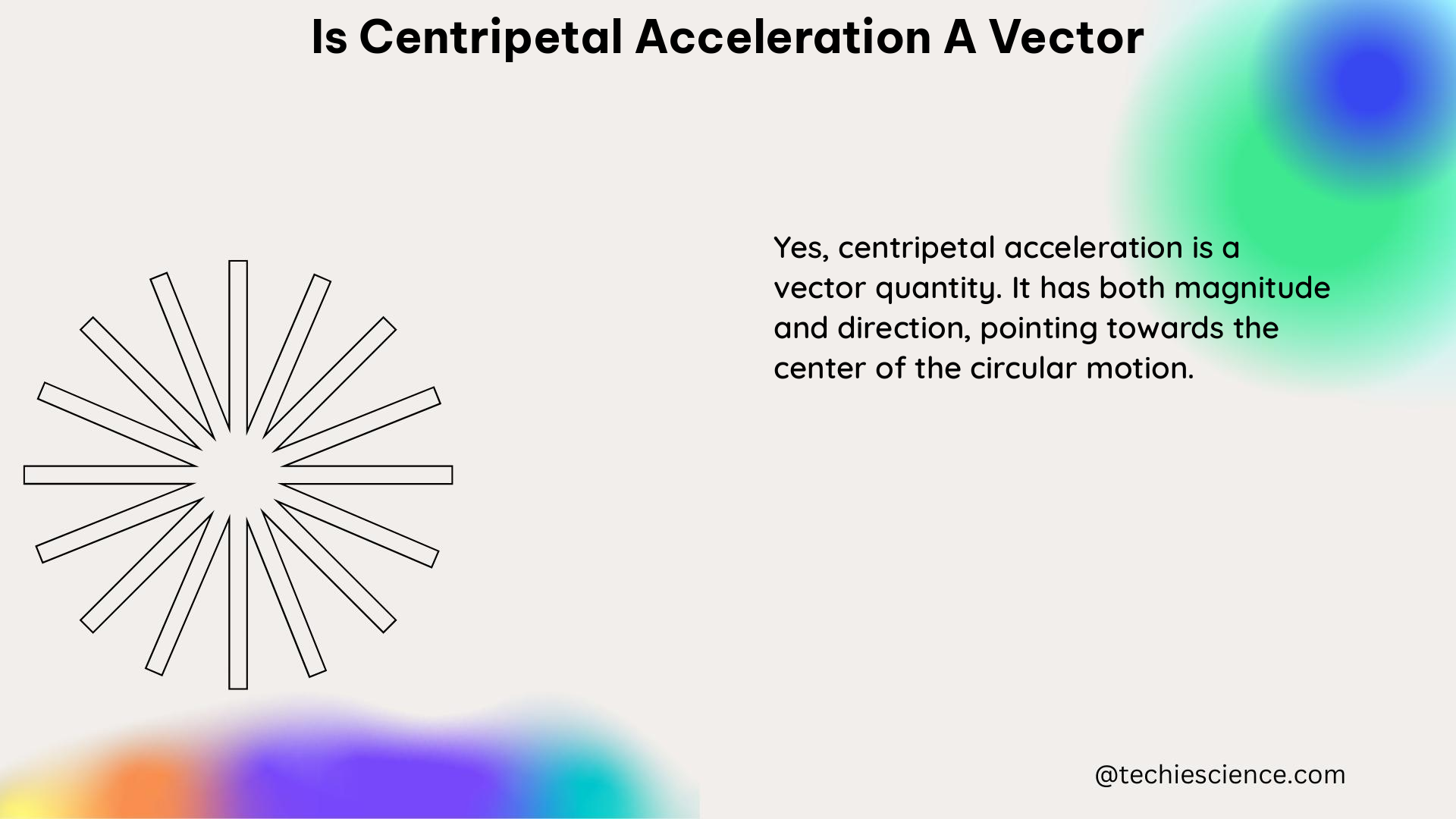Centripetal acceleration is a fundamental concept in physics that describes the acceleration experienced by an object moving in a circular path. This acceleration is always directed towards the center of the circular motion, making it a vector quantity. In this comprehensive guide, we will delve into the details of centripetal acceleration, its mathematical formulation, and its applications in various scenarios.
Understanding Centripetal Acceleration
Centripetal acceleration is the acceleration experienced by an object moving in a circular path. It is directed towards the center of the circle and is responsible for the object’s change in direction, rather than its change in speed. The magnitude of centripetal acceleration depends on the object’s velocity and the radius of the circular path.
The formula for centripetal acceleration is:
$a_c = \frac{v^2}{r}$
where:
– $a_c$ is the centripetal acceleration (in m/s²)
– $v$ is the velocity of the object (in m/s)
– $r$ is the radius of the circular path (in m)
This formula clearly shows that centripetal acceleration is a vector quantity, as it has both magnitude and direction. The direction of the centripetal acceleration is always towards the center of the circular path, while the magnitude depends on the object’s velocity and the radius of the circular motion.
Uniform Circular Motion

In the case of uniform circular motion, where the object’s speed remains constant, the centripetal acceleration can be calculated using the formula:
$a_c = \frac{v^2}{r}$
Here, the velocity $v$ is the constant linear velocity of the object, and $r$ is the radius of the circular path.
For example, consider a car moving at a constant speed of 20 m/s on a circular road with a radius of 50 m. The centripetal acceleration experienced by the car would be:
$a_c = \frac{(20 \text{ m/s})^2}{50 \text{ m}} = 8 \text{ m/s}^2$
The direction of this centripetal acceleration is always towards the center of the circular path.
Non-uniform Circular Motion
In the case of non-uniform circular motion, where the object’s speed is changing, the formula for centripetal acceleration becomes more complex:
$a_c = \omega^2 r + 2\omega v + \alpha r$
where:
– $\omega$ is the angular velocity of the object (in rad/s)
– $v$ is the linear velocity of the object (in m/s)
– $r$ is the radius of the circular path (in m)
– $\alpha$ is the angular acceleration of the object (in rad/s²)
This formula takes into account the changing velocity and radius of the circular path, allowing us to calculate the centripetal acceleration in non-uniform circular motion.
For example, consider a satellite orbiting the Earth with a varying velocity and radius. The centripetal acceleration experienced by the satellite would be calculated using the above formula, taking into account the changes in its angular velocity, linear velocity, and the radius of its orbit.
Centripetal Acceleration in Real-World Applications
Centripetal acceleration is a fundamental concept in many areas of physics and engineering, including:
-
Circular Motion in Vehicles: Centripetal acceleration is responsible for the forces experienced by passengers in vehicles making turns, such as cars, trains, and roller coasters.
-
Satellite Orbits: Centripetal acceleration is crucial in the analysis of satellite orbits, where the satellite’s motion is governed by the balance between centripetal acceleration and gravitational forces.
-
Rotational Machinery: Centripetal acceleration plays a role in the design and analysis of rotating machinery, such as turbines, centrifuges, and flywheels.
-
Particle Accelerators: In particle accelerators, such as cyclotrons and synchrotrons, charged particles are accelerated in a circular path using centripetal acceleration.
-
Centrifugal Pumps: Centripetal acceleration is the driving force behind the operation of centrifugal pumps, which are widely used in various industrial and domestic applications.
Conclusion
In summary, centripetal acceleration is a vector quantity that always points towards the center of a circular path. Its magnitude depends on the object’s velocity and the radius of the circular motion, and it plays a crucial role in various physical phenomena and engineering applications. Understanding the concept of centripetal acceleration is essential for a comprehensive understanding of circular motion and its implications in the real world.
Reference:
- Centripetal Acceleration | Definition, Equation & Formula – Lesson
- Proof of centripetal acceleration formula ($a_c = v^2/r$) for non-uniform circular motion
- How does centripetal acceleration have direction/vector and magnitude while in the formula $v^2=v⋅v$ is scalar?
- Physics Lab Evaluation Questions Flashcards | Quizlet
- Centripetal Acceleration Report Sheet 1 .docx – Course Hero
Hi…..I am Harshitha H N. I have completed my master’s in Physics from the University of Mysore with a specialization in Nuclear physics. I enjoy exploring new things in my free time. My article always aims to develop and bring some value to the table with relevant topics.
Let’s connect through LinkedIn-